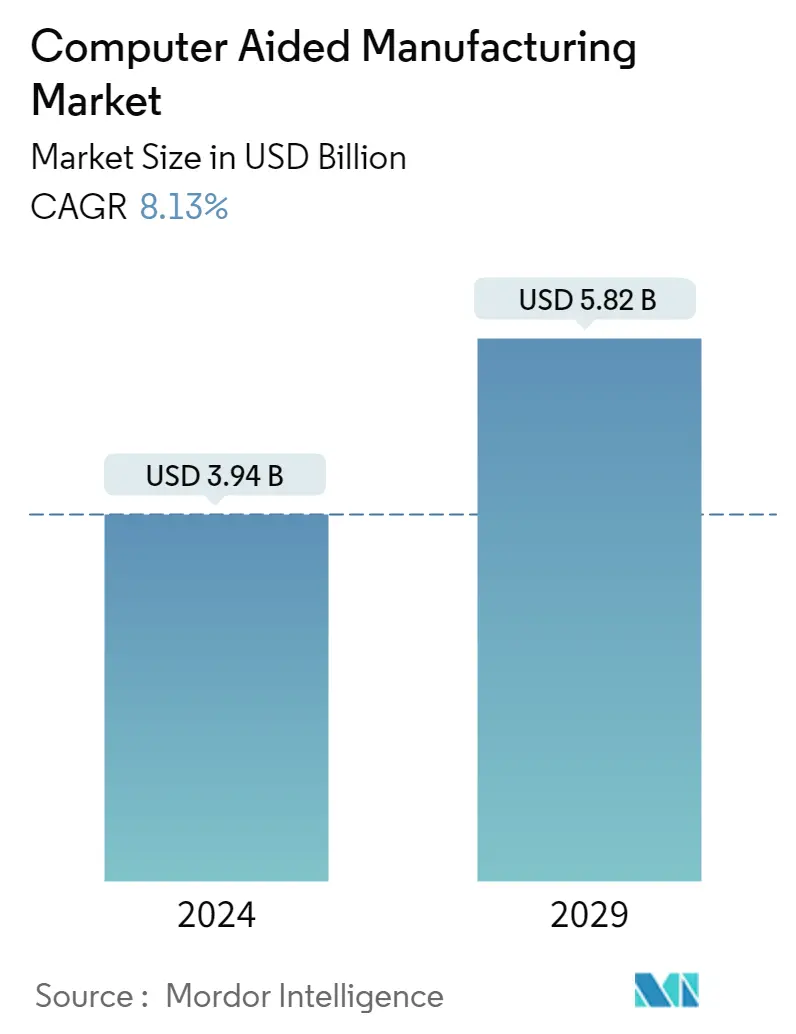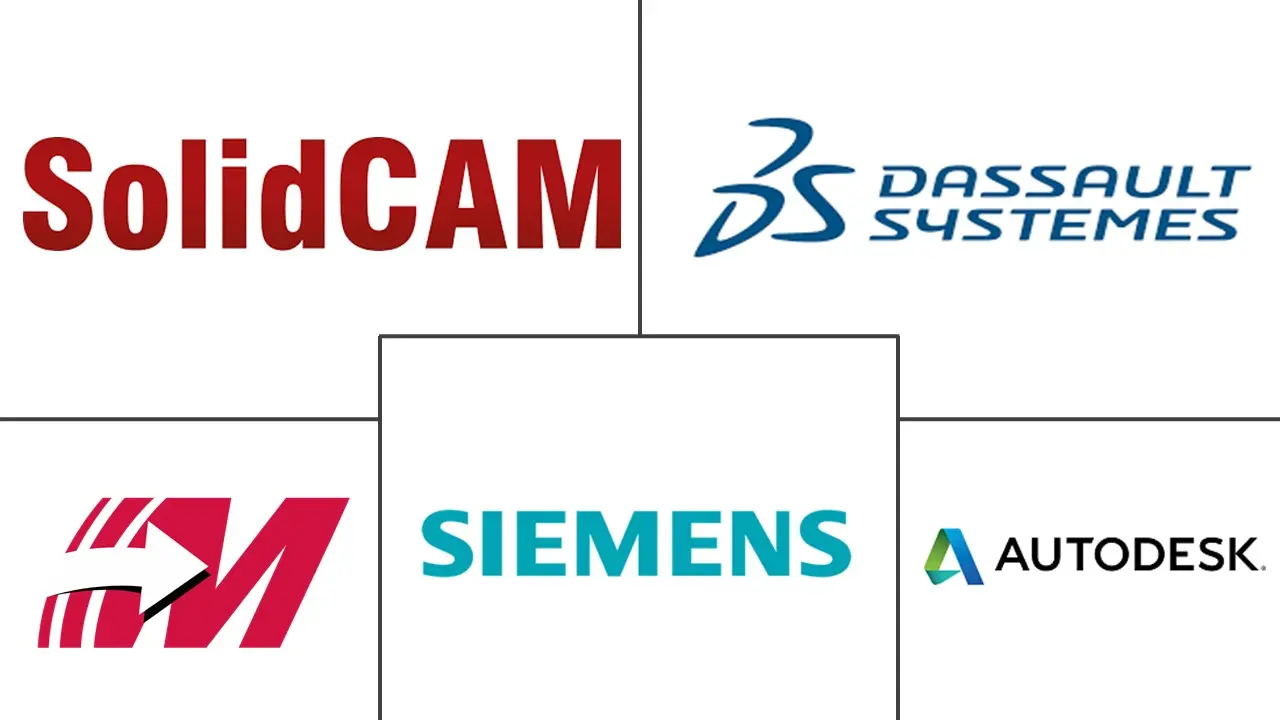Market Size of Computer Aided Manufacturing Industry

| Study Period | 2019 - 2029 |
| Market Size (2024) | USD 3.94 Billion |
| Market Size (2029) | USD 5.82 Billion |
| CAGR (2024 - 2029) | 8.13 % |
| Fastest Growing Market | Asia Pacific |
| Largest Market | North America |
Major Players
*Disclaimer: Major Players sorted in no particular order |
Computer Aided Manufacturing Market Analysis
The Computer Aided Manufacturing Market size is estimated at USD 3.94 billion in 2024, and is expected to reach USD 5.82 billion by 2029, growing at a CAGR of 8.13% during the forecast period (2024-2029).
Computer-aided manufacturing (CAM) helps reduce energy and waste for enhanced manufacturing and efficiency in production via increased production speed, consistency of raw material, and tooling accuracy. Rapid industrialization and the trend of industrial automation are propelling the computer-aided manufacturing market growth.
- Technological advancements across various manufacturing units have aided computer-aided manufacturing (CAM) adoption. Furthermore, Industry 4.0 and the Industrial Internet of Things (IIoT) have made the market accessible, as it has become easier to convert machines into intelligent and connected devices in the manufacturing industry. Manufacturing processes have become accessible via a single control center and wearables, improving operational processes and usability.
- The number of IoT-connected devices in the manufacturing sector will increase during the forecast period. Cisco's annual Visual Networking Index states that machine-to-machine (M2M) connections accounted for over half of the world's 28.5 billion connected devices in the previous year.
- CAM technology significantly reduces the time required to design and prototype quickly without reconfiguring the manufacturing line. This is increasing the deployment of CAM solutions across various industry verticals. CAM solutions further ensure that mission-critical machines are maintained, which helps to increase efficiency, resulting in high-quality products.
- CAM is also used in the medical field with technological advancement. Subtractive milling is the most widely used CAM protocol in dentistry, as it offers an alternative method of fabricating oral and facial prostheses. The United Nations Development Programme (UNDP) in Rwanda recently collaborated with Swiss Limbs and the Home de la Vierge des Pauvres (HVP) Gatagara to launch a 3D computer-aided design and the manufacturing of orthotics and prosthetics.
- COVID-19 also discouraged market growth. Because of the high associated costs, small manufacturers could not adopt it, lowering the market adoption rate significantly. Vendors operating in the aerospace, and automotive verticals have suffered significantly due to reduced spending during the pandemic. However, the shift from proprietary software to cloud-based subscriptions is anticipated to provide profitable opportunities for market growth in the post-pandemic era.
Computer Aided Manufacturing Industry Segmentation
Computer-aided manufacturing (CAM) uses software and computer-controlled machinery to automate manufacturing processes . CAM software assists engineers, architects, and designers in the fabrication and design of objects. CAM systems differ from numerical control (NC) forms as the geometrical data is encoded mechanically. Aerospace and semiconductors are some of the high-tech industries that pioneered computer modeling to test products.
The computer aided manufacturing market is segmented by end-user industry (aerospace & defense, automotive, medical, energy & utilities, and other end-user industries) and geography (North America, Europe, Asia-Pacific, Middle East & Africa, and Latin America).
The market sizes and forecasts are provided in terms of value (USD) for all the above segments.
| End-User Industry (Revenue in USD million and Market Share as a part of the study) | |
| Aerospace & Defense | |
| Automotive | |
| Medical | |
| Energy & Utilities | |
| Other End-User Industries |
| Geography (Revenue in USD million and Market share as a part of the study) | |
| North America | |
| Europe | |
| Asia-Pacific | |
| Latin America | |
| Middle East and Africa |
Computer Aided Manufacturing Market Size Summary
The computer-aided manufacturing (CAM) market is poised for significant growth, driven by rapid industrialization and the increasing trend of industrial automation. CAM technology enhances manufacturing efficiency by reducing energy consumption and waste, while improving production speed, material consistency, and tooling accuracy. The integration of Industry 4.0 and the Industrial Internet of Things (IIoT) has further facilitated the adoption of CAM, enabling machines to become intelligent and connected devices. This technological advancement allows for streamlined manufacturing processes through centralized control and wearable technologies, thereby improving operational efficiency. The automotive and medical sectors are notable adopters of CAM, with its applications ranging from automotive design simulations to advanced prosthetic manufacturing. Despite challenges posed by the COVID-19 pandemic, such as high costs hindering small manufacturers' adoption, the shift towards cloud-based CAM solutions is expected to drive market growth in the post-pandemic era.
North America is anticipated to lead the CAM market, largely due to the high adoption rate of industrial robotics and CAM technologies in the United States. The region's focus on automating processes to enhance efficiency and reduce labor costs has been a significant factor in this growth. The development of smart factories, which integrate advanced technologies like machine learning, AI, and robotics, is further propelling the market. The fragmented nature of the CAM market sees numerous players continuously innovating to meet evolving industry demands. Recent advancements include Hexagon's Power Portfolio and Dassault Systèmes' partnership with ISAE Group, which aim to enhance manufacturing processes across various sectors. These developments, alongside NVIDIA's Omniverse for digitalizing manufacturing workflows, underscore the dynamic nature of the CAM market and its potential for continued expansion.
Computer Aided Manufacturing Market Size - Table of Contents
-
1. MARKET INSIGHTS
-
1.1 Market Overview
-
1.2 Industry Attractiveness - Porter's Five Forces Analysis
-
1.2.1 Bargaining Power of Suppliers
-
1.2.2 Bargaining Power of Consumers
-
1.2.3 Threat of New Entrants
-
1.2.4 Threat of Substitute Products
-
1.2.5 Intensity of Competitive Rivalry
-
-
1.3 Market Drivers
-
1.3.1 Increasing Adoption of Industry 4.0
-
1.3.2 Growing Utilization of CAM Software in the Packaging Machinery Sector
-
-
1.4 Market Restraints
-
1.4.1 Wide Availability of Open Source CAM Software
-
-
1.5 Impact of COVID-19 on the Computer Aided Manufacturing (CAM) Market
-
-
2. MARKET SEGMENTATION
-
2.1 End-User Industry (Revenue in USD million and Market Share as a part of the study)
-
2.1.1 Aerospace & Defense
-
2.1.2 Automotive
-
2.1.3 Medical
-
2.1.4 Energy & Utilities
-
2.1.5 Other End-User Industries
-
-
2.2 Geography (Revenue in USD million and Market share as a part of the study)
-
2.2.1 North America
-
2.2.2 Europe
-
2.2.3 Asia-Pacific
-
2.2.4 Latin America
-
2.2.5 Middle East and Africa
-
-
Computer Aided Manufacturing Market Size FAQs
How big is the Computer Aided Manufacturing Market?
The Computer Aided Manufacturing Market size is expected to reach USD 3.94 billion in 2024 and grow at a CAGR of 8.13% to reach USD 5.82 billion by 2029.
What is the current Computer Aided Manufacturing Market size?
In 2024, the Computer Aided Manufacturing Market size is expected to reach USD 3.94 billion.

